SiFive Announces First RISC-V OoO CPU Core: The U8-Series Processor IP
by Andrei Frumusanu on October 30, 2019 10:00 AM EST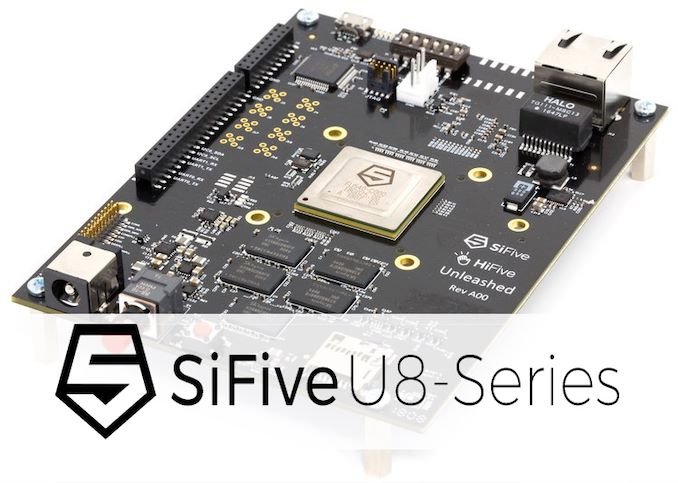
In the last few year’s we’ve seen an increasing amount of talk about RISC-V and it becoming real competitor to the Arm in the embedded market. Indeed, we’ve seen a lot of vendors make the switch from licensing Arm’s architecture and IP designs to the open-source RISC-V architecture and either licensed or custom-made IP based on the ISA. While many vendors do choose to design their own microarchitectures to replace Arm-based microcontroller designs in their products, things get a little bit more complicated once you scale up in performance. It’s here where SiFive comes into play as a RISC-V IP vendor offering more complex designs for companies to license – essentially a similar business model to Arm’s – just that it’s based on the new open ISA.
Today’s announcement marks a milestone in SiFive’s IP offering as the company is revealing its first ever out-of-order CPU microarchitecture, promising a significant performance jump over existing RISC-V cores, and offering competitive PPA metrics compared to Arm’s products. We’ll be taking a look at the microarchitecture of the new U8 Series CPU and how it’s built and what it promises to deliver.
As a bit of background on the company, SiFive was founded in 2015 by the researchers who invented the RISC-V instruction set at UC Berkeley back in 2010. The company’s goal was to develop and implement CPUs and IP based on the RISC-V ISA and produce the first hardware based on the technology. The company first full-blown CPU IP that was able to run a full OS such as Linux was the U54 series which was released in 2017, and ever since SiFive has been in an upward trend of success and hypergrowth.
Introducing the U8-Series - A Scalable Out-of-Order RISC-V CPU Core
Up until now, it’s been relatively unsurprising that if you’re designing a new CPU based on a new ISA, you first start out small and then iterate as you continue to add more complexity to your design. SiFive’s U5 and U7 series as such have been relatively more simplistic in-order CPU microarchitectures. While offering functionality and being very cost-effective options and alternatives compared to Arm’s low-end and microcontroller cores, they really weren’t up to the task of more complex workloads that needed more raw performance.
The new U8-Series addresses these concerns by massively improving the performance that can be delivered by the new microarchitecture – outpacing the U54 and U74 by factors of up to 5-4x, a quite significant performance jump that we don’t usually see very often in the industry.
The new CPU IP’s performance promises to vastly expand SiFive’s and the RISC-V’s ecosystem viability in end-point products, and really be able to offer alternatives to the embedded Arm products in the world today and in the future.
SiFive’s design goals for the U8-Series are quite straightforward: Compared to an Arm Cortex-A72, the U8-Series aims to be comparable in performance, while offering 1.5x better power efficiency at the same time as using half the area. The A72 is quite an old comparison point by now, however SiFive’s PPA targets are comparatively quite high, meaning the U8 should be quite competitive to Arm’s latest generation cores.


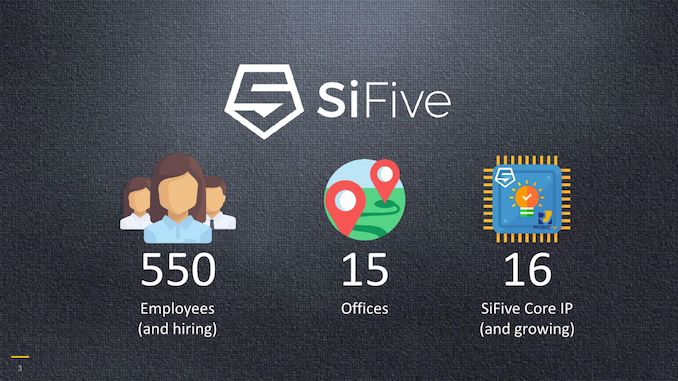

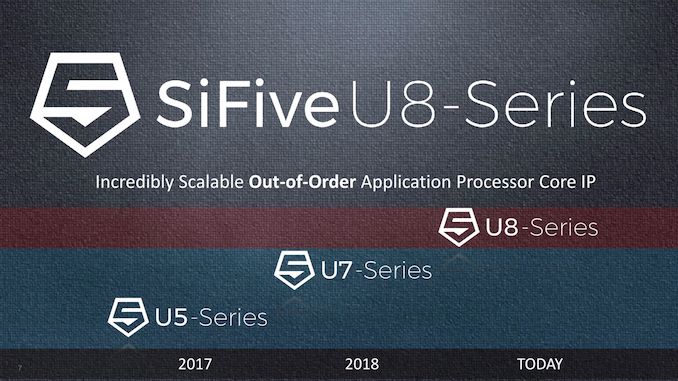
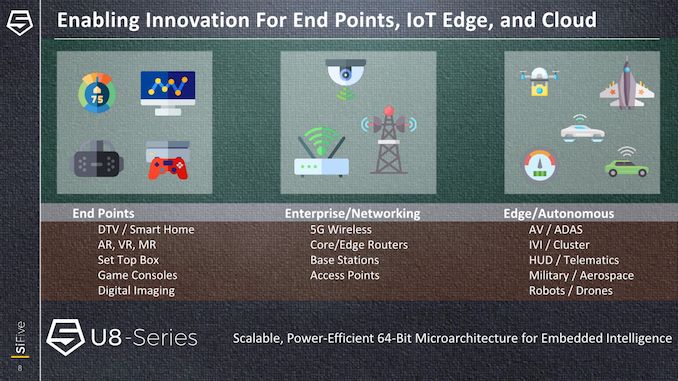
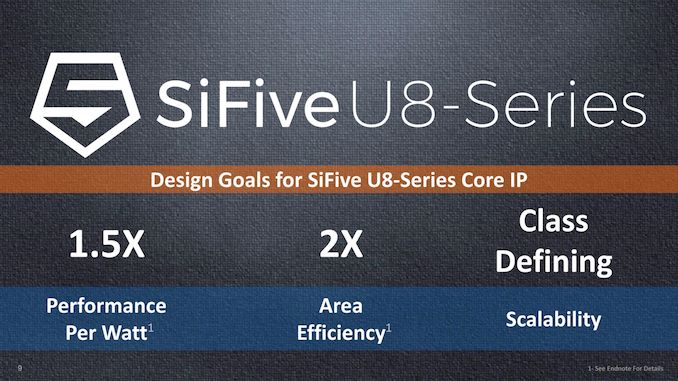








68 Comments
View All Comments
The_Assimilator - Wednesday, October 30, 2019 - link
Half a decade and they don't even have a production part with SIMD or vector capabilities? Arm has nothing to worry about.bji - Wednesday, October 30, 2019 - link
That seems particularly short-sighted. Your criteria for ARM needing to worry apparently is production silicon with vector capabilities and according to this article that will be available next year.PeachNCream - Wednesday, October 30, 2019 - link
It is a valid point right now to argue that RISC-V isn't a threat while production parts are not available to purchase. Ad present, even if I wanted to acquire a competing product, I would be unable to due to the lack of ability to make an acquisition. The situation may change next year, but we won't know until we see what both ARM and RISC-V look like at that point. The dynamics may change on both sides of that coin after time has passed.bji - Wednesday, October 30, 2019 - link
Strawman. He didn't say they are not a threat. He said ARM has nothing to worry about. The distinction is slim I admit and also just semantic, but the sentiment I read from The_Assimilator was more about how this company has not produced a product that ARM would need to worry about in half a decade and by saying that ARM has nothing to worry about, implies that they will not be producing any product that would compete with ARM for a long time. But the article states that the will be releasing the product that The_Assimilator says compete with ARM next year, and any company would naturally worry about a competing product that close on the horizon.In terms of being threatened, ARM cannot be threatened by something that cannot exist. But they may want to worry, i.e. take seriously the notion that a competitor may be threatening them soon.
bji - Wednesday, October 30, 2019 - link
"by something that cannot exist" should have been "by something that does not exist". Post editing, Ananadtech-style!PeachNCream - Wednesday, October 30, 2019 - link
Okay, that's cool.There's never anything wrong with competitive designs. Either way, we are likely to enjoy improvements that result from various interests attempting to get ahead of one another so it's good all the same no matter what the outcome.
Sivar - Wednesday, October 30, 2019 - link
ARM was able to take over because of its inherent advantage over x86: Efficiency. As R&D advanced, ARM cores like the Apple A* line and Qualcomm Snapdragon have slowly worked towards Intel-level performance.MIPS has no large inherent benefit over ARM, but it has some of the same disadvantages vs. x86 such as larger executable code size. MIPS is an elegant architecture and lacks some of the strange baggage the architectures have (read about THUMB some time) but the story of semiconductors does have elegance as a main protagonist. See Intel's history of success as an example.
rrinker - Wednesday, October 30, 2019 - link
Indeed, back in the early 8 bit days, the RCA CDP1802 was absolutely the most elegant architecture, but most people probably day "the what?". Outside of some niche applications, where the completely static nature allowed it to clock down to 0 and draw picoamps, and it being all CMOS so low power even when running, and being available in rad hardened form, it was all but invisible in the pre-IBM PC 8 bit days. Elegance doesn't equal design wins.Sivar - Wednesday, October 30, 2019 - link
Interesting, I hadn't heard of this. I wonder if the same principles could be applied to idle processors today. Now if only Android would let the CPU go idle for more than a few ms.rrinker - Wednesday, October 30, 2019 - link
The registers and such aren't static though, I don't think, on most modern processors, so they have to run at some minimum clock rate to be refreshed. Unused elements can be turned off today, and with turbo you have varying frequency, but the old 1802 could run from 0-4MHz (or 6, or 8, or as high as 12MHz in the last variants. It was almost RISC-like, as well, just 91 instructions, and that very well organized (for Hex, Intel just loved Octal so the 8080 instruction set it highly aligned for octal - it makes no sense in hex). Most 1802 contemporaries had a very small register count - the 1802 has 16x16 general purpose registers plus accumulator and a coupe others. Of the 16, any one could be program counter, which could be switched on the fly (that's how they did subroutine calls with no CALL instruction), and any could be the index pointer for memory directed operations, also switchable on the fly, which means the 1802 has the best operand ever - SEX, for SEt indeX. It was my first computer, and later when I had to add an assembly routing to an Apple 2 BASIC program to get proper performance, I was hugely frustrated by the lack of registers int he 6502. SO many people worship the 6502, I frankly hated the thing. 1802 remains my favorite 8-bitter, followed by the Z80. Best part is, that computer I built from a kit more than 40 years ago still works perfectly.